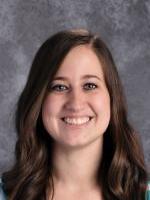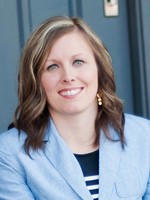


Elementary teachers often use a rotation model for independent activities while they are doing small group literacy instruction. These small groups are formed based on students’ abilities and skills. While teachers are meeting with these groups, the remaining students are working independently on center activities at their desks or around the room. Traditionally, teachers use a timer to rotate students every 15 or 20 minutes. In this format, students rotate between centers at the same time that teachers rotate groups. This center time typically lasts for an hour.
Organizing Blended Literacy Centers on a digital platform such as Google Slides allows students to have more autonomy over their learning path and pace, which are elements of effective blended learning. With Blended Literacy Centers, students have choice over the order in which they complete their centers. We have observed student choice is very motivating for students because some like starting with their favorite while others like saving their favorite center to do last. When using Blended Literacy Centers, students can switch to the next center at their own pace and do not have to rotate when the teacher switches groups. Teachers can determine which centers have timers and which centers allow students to complete the task at their own pace. Organizing centers in this manner helps students to complete better quality work because they can take more time on a center when necessary and not waste time if they finish a center early. Teachers also benefit from this methodology because their time with small groups can be more flexible. Instead of being on a time-driven schedule, teachers can meet with small groups for a shorter or longer amount of time based on the group’s needs. We will provide a slideshow of examples for educators to explore so that they can experience the benefit of being in control of their path and pace during our presentation.
Organizing Blended Literacy Centers with Google Slides allows teachers to add elements of Universal Design for Learning to support all students. We will provide tips for using various technology tools so teachers can add audio directions, videos, and images when creating Blended Literacy Centers for their students. We will show examples of what this looks like for students as well. These additions help students to be independent while still being supported with the tasks they are working on. Because students are able to work independently, teachers are able to focus on the personal interactions they are having with their small groups.
In our session, educators will be encouraged to create intentional centers so their face-to-face instruction is matching the activities during Blended Literacy Centers. We will emphasize the importance of thinking about the learning goal of each center. We will share resources where educators can find literacy resources matching their learning goals. Teachers will also explore examples to see how this has been done in our district.
Educators will leave our session with the resources to aid in creating their own Blended Literacy Centers. We will provide templates and places to find other free resources so that they can customize their own slideshow. We will provide videos to support educators as they create their Blended Literacy Centers using Google Slides and other technology tools in new ways.
We have found Blended Literacy Centers to be very successful and now widespread in our district. We have collaborated with the literacy coaches in our district to set up and continue to adapt best practices for Blended Literacy Centers. In our district, teachers have reported that engagement and focus during independent time has improved significantly. We have observed teachers have become more intentional in the selection of activities during this independent time. Students are taking more ownership of their learning because they are given more freedom to choose the order of their activities and be in control of their pace. Students have been more successful at completing learning tasks because of the different supports (audio directions, videos, images, etc.) the teacher provides within the given tasks. As teachers in our district have shared their success with their colleagues, we have seen an increase of teachers moving from traditional centers to Blended Literacy Centers every year. Teachers have also indicated because their students are able to complete their literacy tasks more independently, they are able to focus more on small group instruction. Because of the success we have seen, a neighboring district invited us to teach their literacy and digital learning coaches how to implement this practice within their district.
In this Interactive Session, given a 60 minute format, we will present the following:
Introduction of ourselves and blended learning (5 minutes): As teachers enter, they will answer a couple questions on a Padlet so that we have a better understanding of our audience. Then, we will introduce ourselves and teach about blended learning and ask a few educators to share what stands out to them.
Explanation of how Blended Literacy Centers work (4 minutes): Educators will listen to an explanation of what the Blended Literacy Centers are and how Google Slides can be utilized to organize the centers for students.
Video with teacher interview (6 minutes): Educators will watch a video all together and then share with a neighbor their take-aways. The video is an interview with a second grade teacher from our district where she reflects on how Blended Literacy Centers are working in her classroom and the benefits that she has observed with her students.
Participants explore slideshow (20 minutes): Educators will go through a slideshow of examples and resources. During this time, there will be a Google Form for them to submit questions. We will walk around and interact with educators while they explore the slideshow and review submissions to the Google Form to adapt the rest of the presentation to their specific questions.
Discussion of what benefits they saw and what stood out to them: Educators will share their thoughts with the whole group.
Tips and tricks (12 minutes): Educators will listen as we share creation and management tips from our experiences implementing Blended Literacy Centers in classrooms.
Show resources: tutorial videos, templates, research, social media groups (6 minutes): Educators will look through resources provided to them that they can utilize after our session. There will be resources to learn more about Blended Learning and Universal Design For Learning. There will also be tutorial videos and templates to help them design their own Blended Literacy Centers.
Answers to questions (7 minutes): Educators will listen as we answer commonly asked questions from the Google Form. We will follow-up with educators if we don’t have time to answer their questions during the whole group discussion.
K-12 Blended Teaching by Charles R. Graham, Jered Borup, Cecil R. Short, & Leanna Archambault
https://edtechbooks.org/k12blended
“Digital Learning Stations” by Holly Clark https://www.hollyclark.org/2022/03/09/digital-learning-stations/
UDL and Blended Learning: Thriving in Flexible Learning Landscapes by Catlin R. Tucker and Katie Novak
“Blended Learning: 4 Models that Work” by Catlin Tucker
https://www.cultofpedagogy.com/blended-learning-4-models/